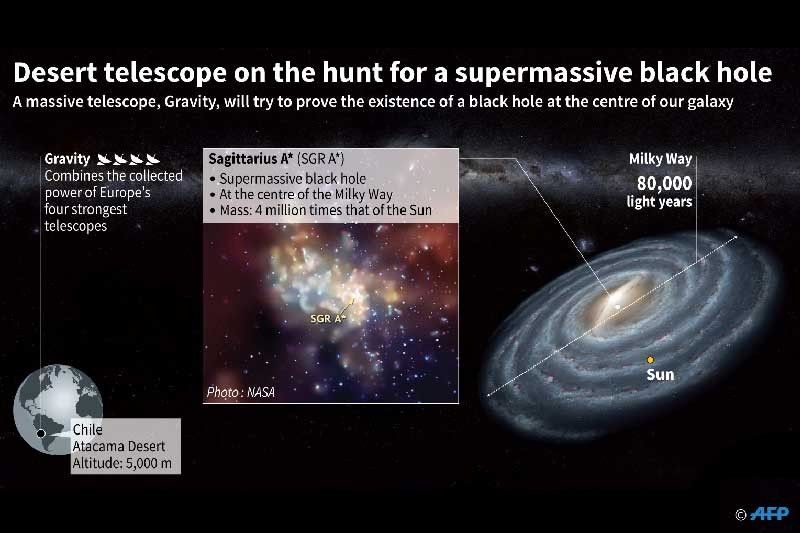Scientists set to reveal first true image of black hole

PARIS, France — The world is finally about to see a black hole—not an artist's impression or a computer-generated likeness, but the real thing.
At six press conferences across the globe scheduled for 1300 GMT on Wednesday, scientists will unveil the first results from the Event Horizon Telescope (EHT), conceived precisely for that purpose.
It has been a long wait.
Of all the forces in the Universe that we cannot see—including dark energy and dark matter—none has frustrated human curiosity as thoroughly as the invisible, star-devouring monsters known as black holes.
Yet, the phenomena are so powerful that nothing nearby—not even light—can escape their gravitational pull.
"Over the years, we accumulated indirect observational evidence," said Paul McNamara, an astrophysicist at the European Space Agency and project scientist for the LISA mission that will track massive black hole mergers from space.
In September 2015, for example, the LIGO gravitational wave detectors in the United States measured two black holes smashing together.
"X-rays, radio-waves, light—they all point to very compact objects, and the gravitational waves confirmed that they really are black holes, even if we have never actually seen one," McNamara told AFP.
Two candidates are vying to be in the first-ever image.
Oddsmakers favor Sagittarius A*, the black hole at the centre of our own spiral galaxy, the Milky Way.
Sag A* has four million times the mass of our Sun, and measures about 24 million kilometres across.
That may sound like a big target, but for the telescope array on Earth some 26,000 light years (245 trillion kilometres) away, it's like trying to photograph a golf ball on the Moon.
The other candidate is 1,500 times more massive still, ensconced in a faraway elliptical galaxy known as M87.
Comparing the two, distance and size balance out, making it roughly as easy (or hard) to pinpoint either.
Ripples in time-space
A black hole is a celestial object that compresses a huge mass into an extremely small space. The more mass, the larger the black hole.
At the same scale of compression, Earth's mass would fit inside a thimble, while the Sun's would be a mere six kilometres from edge to edge.
There are two types.
Garden-variety black holes—up to 20 times more massive than the Sun—form when the centre of a very big star collapses in on itself.
So-called supermassive black holes are at least a million times bigger than the Sun. Both Sag A* and M87 fall into this category.
The EHT is unlike any star-gazing instrument ever devised.
"Instead of constructing a giant telescope we combined several observatories as if they were fragments of a giant mirror," Michael Bremer, an astronomer at the Institute for Millimetric Radio Astronomy in Grenoble, told AFP.
Eight such radio telescopes scattered across the globe—in Hawaii, Arizona, Spain, Mexico, Chile, and the South Pole—zeroed in Sag A* and M87 on four different days in April 2017.
Each is at least a big as a football pitch. Together, they form a virtual telescope more than 12,000 kilometres across, the diameter of Earth.
Data collected by the far-flung array was to be collated by supercomputers at MIT in Boston and in Bonn, Germany.
"The imaging algorithms we developed fill the gaps of data we are missing in order to reconstruct a picture," the team said on their website.
Astrophysicists not involved in the project, including McNamara, are eagerly—perhaps anxiously—waiting to see if the findings challenge Einstein's theory of general relativity, which has never been tested on this scale.
The LIGO experiments from 2015 detected signature ripples in the curvatures of time-space during the black hole merger.
"Einstein's theory of general relativity says that this is exactly what should happen," McNamara said.
But those were tiny black holes compared with either of the ones under the gaze of the EHT.
"Maybe the ones that are millions of times more massive are different—we just don't know yet," McNamara said.
- Latest






























